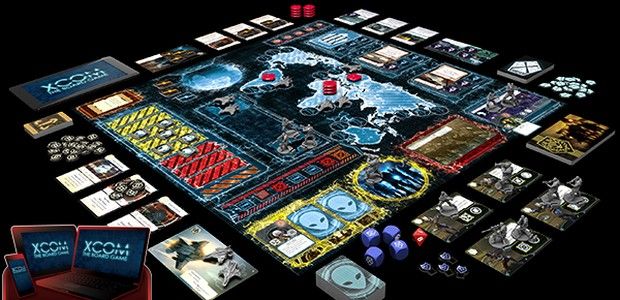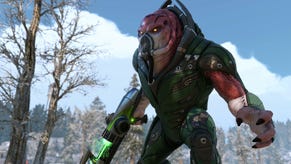Cardboard Children: XCOM: The Board Game - Part 1
Earth Defense Rab
Hello youse. With XCOM being a game that is significant in the history of PC gaming, I thought I would do something a bit different with my coverage of XCOM: The Board Game on Rock, Paper, Shotgun. Often, when a board game supports solitaire play, I'm asked how well the single-player aspect works. And I'm often unable to answer, because I rarely play board games alone. But with XCOM, I thought I would make an effort. The PC game series is a real single-player, one-mind-against-the-machine experience. How does the board game stack up?
In this first part, I look at XCOM: The Board Game for one player. Next week I will talk about how the game scales up to a full team of four.
XCOM: THE BOARD GAME
First things first – there are no rules inside the box.
Opening a board game box to find no rulebook is a bizarre experience. The game requires that you download a free app, for your laptop or mobile device, that will lead you through a tutorial designed to ease you into the board game's systems. I downloaded the thing to my android phone and an iPad, and it works nicely on both. It's slick, easily readable on a small screen, quite attractive on a large screen, and is nicely themed after the most recent XCOM computer game. You can even open it in your browser right now, if you want.
You set up the board according to a short set-up guide. There are four roles in the game. The Central Officer is the person who takes control of the app, relays all the information that the app provides, and sends satellites into space to shoot down UFOs. The Commander is in charge of XCOM finances, and sends jets to deal with any UFOs that are hovering above the continents of Earth. The Chief Scientist allocates scientists to research posts, invents new technologies, and uses alien salvage to aid the human cause. The Squad Leader controls the XCOM troops, deciding how and where they're assigned, on missions and in defence of the XCOM base.
In a 4 player game, each player will assume one of these roles. In a solo game, where we are right now, one player has to do it all. The game's objective – complete missions until a final mission appears. If too much of the world falls into panic, the game ends in failure.
With all that explained, let's press PLAY on the app.
The game round starts with a timed phase where the app starts spitting out alerts and instructions. Every one of those four player roles will have opportunities to act, when called into action by the app. The order of these instructions will change from round to round, keeping everyone on their toes. There will also be alien actions too, with UFOs moving into position and aliens attacking the XCOM base. This is the part of the game where all the decisions are made, against the clock. The Commander takes cash, stacks it up ready to spend. The Chief Scientist draws tech cards, chooses the cards he likes, and decides whether or not to start researching stuff. A mission will appear. Someone on Earth needs help. Maybe it's an abduction, and a rescue. Maybe it's a search and destroy, a bug hunt. The Squad Leader decides which mission to deal with, and decides which of his units to send. But wait! More UFOs have arrived. The Commander sends out some jets. But where to? Which continents are most terrified? Who to prioritise? But wait! Now the base is under attack. Units will need to be kept at the base to defend it. But which units? And does the Squad Leader have enough troops on standby? But wait! UFOs in orbit, trying to block communications. The Central Officer can activate some satellites, sure. But how many? And can we afford it?
Commander, can we afford it?
Robert, can we afford it? Can I afford it?
The timed phase is fast and furious, with lots of alien activity and an overwhelming amount of decisions for one player to cope with. Almost everything you do on the game's physical board costs money. If you place soldiers out there on a mission, it costs money. If you activate satellites, it costs money. If you send jets, it costs money. As Commander, you are constantly counting and re-counting, making sure you haven't put out more than you can pay for. Regrets start to pile in on top of you. One less soldier on a mission and you could have sent one more jet to defend Australia. One less researcher building armour out of alien hide could have put one more satellite into orbit. The Commander has an emergency funding card with a little stack of cash on it, and there's opportunity in every timed phase to dip into that. But when? Now? Or later? Will there be a later?
And while the Commander counts and worries and counts again, the UFOs keep coming.
SCIENCE
The Chief Scientist always has some interesting tech in hand, and these techs are crucial. But they need to be built. There are three build slots on the board and the timed phase will open them up at different points, spreading the decisions out over the round. Every scientist sent to work on a tech increases the chance of that tech being successfully built. When built, the tech will be given to the relevant department. Weapons and armour will help the troops. New jet tech will go to the Commander. New satellite technology will go to the Central Officer. It's up to the Chief Scientist to work out what the strongest, most efficient spread of new tech will be in each game, and in what order it will be built. It's a crucial role.
In a solo game, it's on you.
IN ORBIT
Above the planet, UFOs prepare for an assault. The Central Officer needs to keep the skies clear. By sending satellites out there he can attempt to bring the UFOs down, and you do not want UFOs in the sky. Any UFOs still in orbit at the end of the round can mess with XCOM communications, causing the next timed phase to spit instructions in a less useful order, clouding player information. It's a beautiful little addition to the flow of the game, and it makes the Central Officer role a key one.
ON THE GROUND
The Squad Leader knows she must complete missions if the game is to end successfully. Missions are made up of tasks and combats, and they will demand different proficiencies from the soldiers sent out there. One mission might need a sniper, and might give bonuses to an assault troop. The Squad Leader will have to hope she still has the necessary soldiers when the time of deployment comes. And how light will base defences be this round? Can the base stand to take a couple of hits? What do you think? You have about 30 seconds to decide. Mission or defence? Both, and hope for good fortune? What if every soldier is lost? Can you recruit more? Can you afford to?
Commander, can we afford it?
Robert, can we afford it? Can I afford it?
PEOPLE IN PANIC
The people of the world hate seeing UFOs above their cities. Don't ask me why. The Commander, when not worrying about money, is trying to shoot those UFOs down. He sends jets to Europe, Africa, maybe one jet to America. The more jets the better, of course. But there aren't more jets. He can't afford them.
Do we let a continent slide into panic? Is one of them a lost cause? Can we afford it? If panic spreads there is less income for XCOM. Can we afford it, Robert?
REGRET AND REDEMPTION
When the timed phase ends, we roll some bones.
After all the cool app-side stuff, we get down to the traditional rolling of lovely, lovely dice. Here's where some of the most magical moments in board games are hidden after all – in the click-clack-clatter of dice on a table, under the shadow of the hand of fate.
It's all resolved so simply, after all that panic.
The game's blue six-sided dice each show two success symbols and four blanks. There is a red alien die, a d8, that is always rolled with them.
Every single task in the game, whether it's research or air-to-air combat or ground troop battles or a mission, is pretty much a matter of scoring a certain number of successes. For every unit allocated to the task, a blue die can be rolled. Failure to get enough successes will leave a tech half-built, or some UFOs still in orbit, or a continent still in terror, or a mission incomplete, or a base ready to be battered.
But you can PUSH your units to work harder, fight harder, if you want. That's where the red alien die comes in - that terrible red die that accompanies every single roll. On a first roll on a task, the alien threat is at 1. Only by rolling a 1 on the red die will disaster occur. If you PUSH your XCOM troops, you can re-roll your dice to try to get more successes. But the threat level will rise. Now a 1 or 2 on the red die will cause disaster. And you can keep pushing, all the way up to a threat level of 5.
And disaster really is disaster. Every jet on a continent destroyed. Every soldier on a task killed. Every researcher exhausted, out of use until much later.
It's risk. Pure, tempting, sometimes essential risk. And it's the kind of risk-taking that just has to be done on a board, with physical dice.
It's exactly where I said out loud “I get it. Now I get it.”
THE GAME CONTINUES
Everything gets paid for, and any money left over is used to recruit more troops and jets. Any UFOs left above cities cause panic, and the game state changes.
The app asks some questions of you. How many UFOs still in orbit? How are the people feeling? Are they in terror? How is your base? Still standing?
“BASICALLY, ROBERT, ARE YOU DEAD YET?” it asks, coldly. And then a new round begins, if you're lucky.
THE IMPOSSIBLE PUZZLE
As a solo game, XCOM: The Board Game hits you like a fraught, tense, impossible puzzle. You are everything and everybody, one against all, and you are against the clock. Each role has special abilities that I haven't discussed in detail. But they are major, game-changing abilities that allow for interjection with stuff like “Wait, I could transport your troops from there to here if that helps.” The special abilities create further interactions between players, but in a solo game they just create more stress and more struggle. That's not to say the struggle is unpleasant – in fact, there's something quite exhilarating about having all the decisions, every one, at your own fingertips.
The real-time aspect of the game drives the experience forward at a breakneck pace, and familiarity will be the solo player's friend here. Once you know everything that is in the science deck, decisions will flow faster. Once you have experience with the tactical balance of jet, troop, researcher and satellite, I suspect that your hunches will improve and that your in-the-moment calls from the gut will seem more solid.
In fact, I expect that familiarity in a multi-player game might actually cause more drama and perhaps even some conflict. Four experienced players might have different takes on how the units should be used, and how the money should be spent. “Commander, I must have more troops,” spoken aloud by another, is probably far more stressful than hearing it inside your own head.
The game itself is a fascinating one. The app is relentless, almost menacing, pushing you into decisions before you're ever ready. There seems to be a million things going on at one time. And then you're into that resolution phase, with the brilliant push-your-luck dice rolling. I'm glad the dice system is so simple, because it really feels like the meat of the game is in the decisions you make. The simple dice rolling just tells you if you've done enough to swing the odds in your favour. And then you can push for more, if you dare. It's something that will often punish you, but the rewards can be massive. And I'm glad the dice rolling is there at all – it's a real statement that this is still, after all, a board game.
Weirdly, the game's board doesn't seem to be designed for solo play. Each side of the board belongs to one of the roles, so that four players can sit round a table with only the role-relevant stuff right in front of them. In solo play, if you were to lay out the board as suggested, you'd really need to move round the table as you play to work efficiently. (I actually quite fancy trying this – playing the game on my feet, moving, as if round a battle map in a war room.) The game can easily be laid out in a manner so that everything is at one player's convenience, but it never really feels right, and is quite cluttered.
Before playing the game I had concerns about the app. I play board games to play board games, and I hoped that the app didn't have too much game locked up inside it. It's a relief to find that the app actually works more as a gamesmaster of sorts. It controls the sequencing of each round, keeps everything to time, and pushes all the book-keeping stuff behind the scenes. As the game tilts in the aliens' favour, it re-orders the game's phases so that some of your actions are blind to certain details of the alien invasion, and that's the kind of thing that's very difficult to do in any conventional board game.
To those of you expecting an XCOM board game to be a turn-based, tactical experience with units moving around a grid – this is not that game. Frankly, we have plenty of those games in board gaming, and we hardly need any more. What we do have here is a game that neatly packages that strategic level of XCOM, all that good stuff that happens between the missions. It's a challenging, immersive puzzle, and even in solo mode I've been quite impressed by it. I think some of you might like it quite a bit.
NEXT TIME
How does XCOM play with more humans at the table? With two? With four? And will Rab ever defeat the aliens?


















